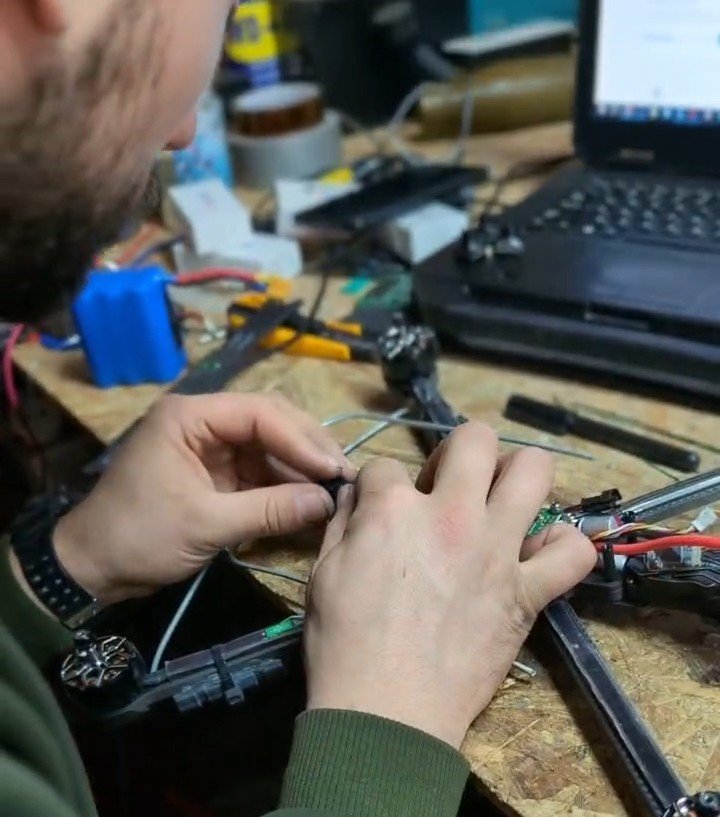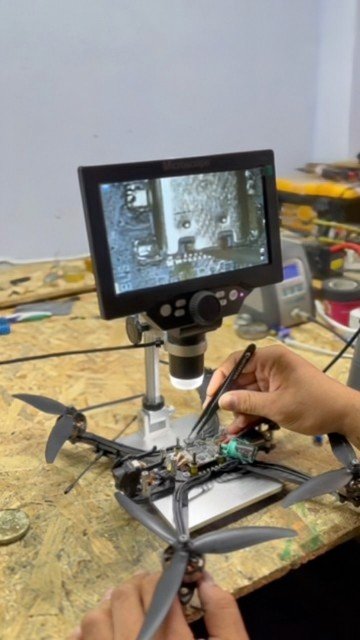From repair to innovation. How frontline FPV drone workshops affect the course of the war
A pilot with the call sign Smoke, having just returned from a three-day combat mission where he fired FPV drones at enemy targets, goes straight to the workshop.
In a special place with shelves, drawers, and long tables with antennas, transmitters, fasteners, screwdrivers, soldering irons, computers, and 3D printers, he is supposed to help with a problem that some drones had with video.
Here is his unit's drone workshop.
Using the example of this workshop, we will tell you how such workshops came to be and how they helped in the war.

"I took off, saw the target, hit it, and exploded." Numerous videos from the frontline can give the false impression that using FPV drones is easy; you need to learn how to operate them. Not every drone will fly correctly and reach its target the first time. The military finds a lot of different kinds of technical and software problems. And they overcome them in drone workshops located near the front line. Here, talented craftsmen repair and improve drones.
How the Workshops Appeared
Small drones are stopping Russian assaults, destroying their equipment, and even finding our wounded - everyone has probably heard about it. Behind the videos of hits, there is a large complex of work "before" and "after" the actual combat work. The military tests each drone, sometimes repairs it, and sometimes improves it, for example, replacing antennas, "reflashing" the settings, and designing its components. And somebody should do it constantly, so drone workshops naturally emerged in units that actively work with drones.
The soldiers gained the experience; the workshops became centers of innovative solutions. After all, every combat pilot has suggestions on how to make their "birds" even more lethal. If their colleagues are talented engineers who can implement these suggestions, the professionalism and effectiveness of the entire unit overgrow.
The drone workshops are located somewhere in frontline villages or towns. Pilots and engineers must exchange ideas daily, which is how dozens of different technical problems are solved, and innovations in the drone industry are born.
How It Works

The pilot with the call sign Smoke, whom we mentioned at the beginning of the article, once in the workshop, immediately hands a flash drive with a flight video to his fellow soldier Dmytro:
"Hey, can you watch the drone video? Do you see how it keeps crashing? What could it be?"
Dmytro is involved in the other side of working with drones - their setup, repair, and engineering. He answers:
"Let's find out. Yeah, it's probably something with the video controller. I'll test how it works on other drones from the same manufacturer. We'll fix it!"
Dima's next mission is in two days. And he will go with drones with the video controller working flawlessly. Dmytro diagnosed and fixed the problem in an hour. Otherwise, he would have had to send the drones from the "defective" batch to the manufacturer for service, and the one-way delivery alone would have taken two days.
That's why Dmytro and Dmytro's unit set up a workshop to diagnose and fix technical problems with drones quickly and directly on the spot rather than sending them to the rear.
Andriy, the commander, called Skiba, one of the best fpv pilots, says: "We are only at the beginning of the journey. And my personal opinion is that technology will win this war. Whoever has the most drones, whoever has the most technology, will win."
Drone Engineers
There is no official position for a "drone engineer." Until recently, there was no official "drone pilot" position either. Although now such respected formations as the Army of Drones are the world's first new branch of the military, the Unmanned Systems Forces, all of this was born in trenches and plantations, in forests and the remains of destroyed villages, invented by ordinary and field commanders who wanted to fight off a mighty enemy somehow and survive.

Inside the workshop
The workshop occupies three rooms. The shelves and tables contain everything needed: antennas, ties, cables, screwdrivers, microcircuits, blades, soldering materials, and other spare parts and tools. The stock of components is constantly monitored to avoid delays in repairs. There is also a lot of equipment, including several 3D printers, laptops, soldering stations, and even a microscope.
It is a well-equipped workshop with well-established internal processes.
"Not every unit has managed to build such a system. We have the technical base, those who repair, and those who create experimental models. Some dig dugouts and those who fly drones. Pilots from other units are sent to us for initial training or to improve their skills," says military engineer Dmytro. "This ensures stable, uninterrupted work of the entire company.
Taisra's engineers are constantly at work. Some lean over the soldering station, soldering the board to the drone, while others sit at their laptops, checking the drone's firmware. Most of the work here is done with fpv kamikaze drones.
Every drone that comes to the unit is tested. The basic tests of drones from manufacturers the military knows include video, control, and motor tests. It takes up to 5 minutes. The next step is to change frequencies, internal settings, solder firing boards, sometimes change the antenna's position, and install propellers. It takes about 15-30 minutes. After that, they put it on the "Ready for delivery" shelf.
If an unknown manufacturer sends the drones, they are sent to the field to test how they behave in flight and identify possible problems. The military describes the field trip: "We have to organize the car, take a ground station, go to the field, unfold it, fly it, then put it back together - it all takes about half a day." During this time, they tested about 15-20 drones.
An engineer at work in the drone workshop. Photo provided by the heroes of the publication.
An engineer in the drone workshop at work. Photo courtesy of the authors.
Searching for Solutions
The drone workshop faces new challenges daily and searches for the most effective solutions.
First of all, drones with flaws are being "refined" here. Drone manufacturers have now worked out the weaknesses of their products. But just a few months ago, producers regularly supplied the drones with malfunctions to the army. Dmytro lists them as follows:
"It's true that all drones are different. One has a good camera; the other has good motors but a bad camera; the third seems to be fine, but something turns it around, jiggles it, some settings are wrong, and you can't do anything about it. The fourth seems fine - on you, some control is bad."
Why does this happen? Ukrainian manufacturers supply FPV drones, and they, like the entire field of drones in the war, are new to this engineering. They cannot use the experience of their predecessors because they have no predecessors. Each manufacturer started their development from scratch and was in a great hurry - the army was waiting for their products. Naturally, in such a situation, the producers cannot avoid imperfections. However, each drone developer has greatly strengthened Ukraine's armed forces. But to reduce the time needed to fix the shortcomings that did occur, it was more convenient for the military to do it themselves, right at home. And tomorrow, they can go into battle with the finalized drones.
Secondly, the engineers improve drones here. Combat missions highlight problems you cannot see during test flights at a training ground somewhere in the rear. In the workshop, pilots immediately give feedback on flights, and engineers directly suggest improvements.
A drone repair engineer at work. Photo provided by the heroes of the publication.
Dmytro gives a few examples:
"At some point, our pilots realized that the Russians were calculating their takeoff points by detecting a powerful signal coming from our drones on takeoff. The pilots came to us, the engineers, and said: "Make it so that we can change the signal strength right during the flight. So that when we first take off, the power is minimal, and the Russians cannot detect our signal.
And then we could turn the video transmitter on to maximum with the remote control." We Googled it, changed the program code, then flashed all the drones, and did everything as the pilots asked."
Another example: the pilots concluded that the drone's control before the strike was inaccurate. They needed the drone's antenna to be vertical rather than horizontal to improve it. We came to the engineers with this request. The engineers designed a new mount model, printed it on a 3D printer (right in the workshop), and mounted the antenna on each drone in a new position. We conducted test flights. And it was a success - the control during the direct approach to the target became much better.
Third, the masters are experimenting. They are increasing the batteries' capacity, extending the antennas' range, and developing new component models. Engineer Andriy is developing a new model of "drops" - "peg" mounts where the drone carries a projectile to enemy positions.
Andriy explains, "The drop sites break, and ordering them is expensive. Moreover, I will make a model that will best suit our needs. Here, the process of experimentation is much faster because we can quickly go through several rounds of tests and improvements, and in a couple of days, we can have a product that will work well."
The workshop also developed entirely new models of drones, photos of which I was not even allowed to publish.
But everything goes smoothly; only some things are easy. The most exhausting thing is that the problems are different every time.
"Every day it's something new," says Dmytro. - "Broken drones, broken Starliners, masts, equipment. Some new "tricks" with drones. Some people come, some leave. Someone died, someone was wounded. I could go on for a long time. The main thing is that something happens every day, and everything is very dynamic, and sometimes, you need more time to understand whether it's real or not. And every day you accept these challenges, and you solve something, you solve it all the time."
Work in the workshop is for the creative and persevering. The working day lasts 12-14 hours.
Giant drones they send to manufacturers
The workshop mainly repairs small drones. If a problem arises with large drones, such as the Bat, Vampire, or Avenger, for example, the drone does not take off due to software problems or crashes near the takeoff point for an unknown reason, it is sent to the manufacturer for service, because these are large unmanned systems and their high-quality repair is possible only in such conditions.
But all kinds of work with smaller drones, whether they are kamikazes that crash and "die" together with the target or bombers that repeatedly drop shells on enemy targets, is more rational to do in a frontline workshop such as the one created by the Taisra company of attack drones.
Workshops like this are a crucible where the manufacturers' product is brought to the state of an almost perfect killer bird.

